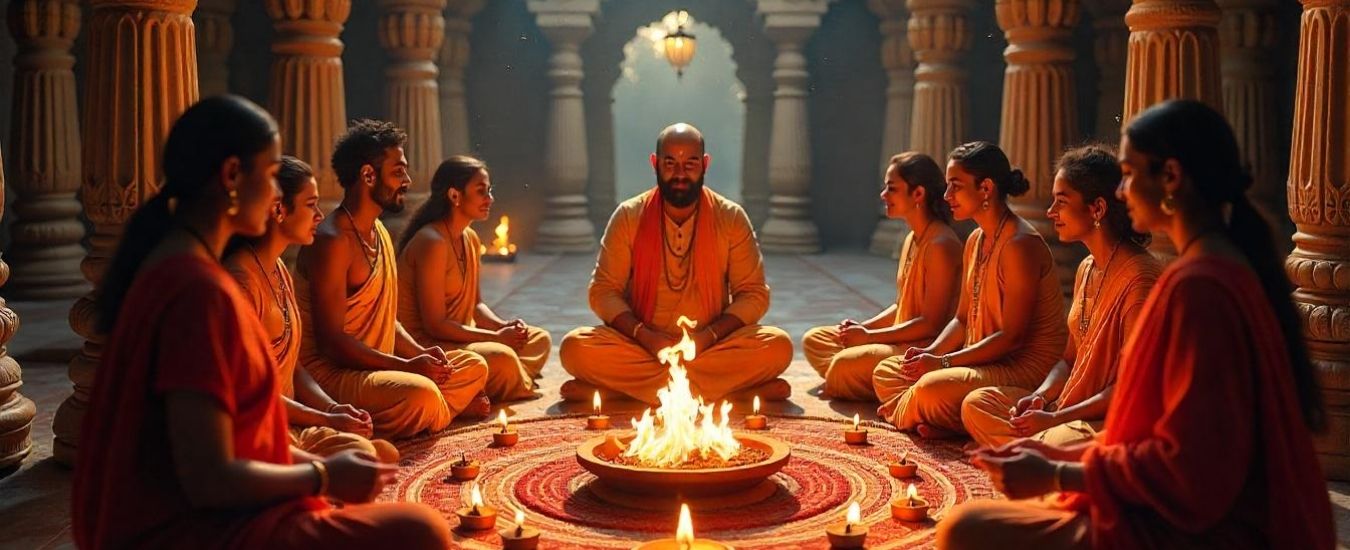Let’s start simple—Nav Grah literally means Nine Planets. But in Vedic Astrology or Jyotish Shastra, they’re way more than just floating rocks. These celestial influencers shape your life’s journey—from your emotions to your relationships and even your career choices.
Nav Grah Shanti Pooja isn’t just about warding off bad luck. It’s about resetting your karmic energy, finding emotional and financial stability, and stepping into spiritual alignment.
Whether done at a temple or as a Virtual Pooja, this Graha Shanti Vidhi can help you achieve clarity, peace, and purpose. Especially when combined with the wisdom of Jyotish Shastra, Vastu Shastra, and daily spiritual discipline.
What Are Nav Grah?
These nine are Surya (Sun), Chandra (Moon), Mangal (Mars), Budh (Mercury), Guru (Jupiter), Shukra (Venus), Shani (Saturn), Rahu, and Ketu. Together, they’re the cosmic committee behind every up and down in your Kundli (birth-chart).
How Do These Planets Influence Our Lives?
Each graha has its superpower—and sometimes, superproblem. When aligned well, they bring success. But if they’re afflicted or caught in a transit (Gochara) phase, expect delays, drama, and doshas!
Understanding Doshas and Malefic Effects
In Jyotish Shastra, doshas are imbalances in your Kundli that lead to chaos in life. Think of them like software bugs in your life program. You may have heard of Mangal Dosha, Shani Sade Sati, Pitra Dosha, or Angarak Dosh. These arise from planetary placements and need remedies like Nav Grah Shanti.
Why Perform Nav Grah Shanti Pooja?
Spiritual, Emotional, and Cosmic Benefits
This isn’t just a ritual—it’s a Graha Dosh Nivaran technique. It acts like a detox for your soul. By invoking all nine planets through Shodashopachara, you neutralize their negative impact and activate inner peace.
Astrological Necessity Based on Your Kundli
An expert astrologer analyzes your Nakshatra, Panchang, and Mahadasha to recommend this Graha Shanti Vidhi. The idea is to align your spiritual GPS before things go further off-track.
When Should You Do Nav Grah Shanti Pooja?
Timing matters—a lot. In fact, choosing a Shubh Muhurat (auspicious time) is half the battle. An astrologer will check your Kundli, Panchang, and planetary Gochara to recommend the ideal day.
Some common reasons to do this Pooja Vidhi:
- Before weddings or starting a new job
- After a health scare or constant bad luck
- During intense Shani Sade Sati or Mahadasha
- If you’re experiencing Angarak Dosh or Pitra Dosha
- Before Griha Pravesh (housewarming), especially with Vastu Shastra issues
Nav Grah Shanti Pooja Vidhi (Step-by-Step Guide)
This ritual follows the Shodashopachara format—16 traditional steps that combine mantras, offerings, and spiritual devotion.
Sankalp
You declare your intent. It’s a personal vow to perform the pooja sincerely.
Kalash Sthapana & Kalasha Pooja
A Kalasha (copper pot filled with water, mango leaves, and coconut) is placed to invite divine energies.
Puja Samagri Setup
Items like flowers, rice, ghee, sandalwood, turmeric, and Arghya water are arranged.
Navagraha Avahan (Invocation)
Each Graha is invoked with Beej Mantras and Navagraha Stotra.
Yantra and Trishakti Yantra Placement
Navgraha Yantras and Trishakti Yantra are used to energize and balance energies.
Chanting & Homam (Havan)
Offerings are made to fire with Ashtottara Shatanamavali and specific mantras. This purifies the environment and your karmic field.
Daan (Charity) and Prasad Distribution
Post-pooja, Daan, like food, clothes, or metal, is offered to Brahmins or the needy. Prasad (blessed food) is shared.
Spiritual and Astrological Remedies That Complement the Pooja
While the pooja is powerful, it works best with a holistic lifestyle. Here’s what you can do:
- Fasting on specific weekdays linked to each graham
- Chanting Gayatri Mantra, Om Navgrahaya Namah, or planet-specific mantras
- Wearing recommended gemstones like blue sapphire for Shani or emerald for Budh
- Reciting Navagraha Stotra every morning
- Placing Navgraha Yantras and Trishakti Yantras at home
- Following Vastu Shastra’s corrections, if advised
Can I Do Nav Grah Shanti Pooja Online?
Yes, totally. Many temples and priests now offer Virtual Pooja services. You can participate via Zoom or YouTube Live, send your Puja Samagri, and even receive Prasad by courier. Just make sure your astrologer sets the right Shubh Muhurat, and you’re spiritually ready.
Difference Between Graha Shanti and Other Poojas
| Pooja Type | Purpose |
| Nav Grah Shanti | Balance all nine planetary energies |
| Mangal Shanti Pooja | Specifically for Mars-related issues |
| Shani Shanti | Done during Shani Sade Sati |
| Pitra Dosh Nivaran | For ancestral curse removal |
| Vastu Dosh Pooja | Aligns space energy based on Vastu Shastra |
How to Know If You Need Nav Grah Shanti Pooja?
A professional astrologer will:
- Analyze your Kundli, Nakshatra, and Gochara
- Check for afflictions like Graha Dosh, Shani Sade Sati, or Pitra Dosha
- Suggest the right time and method using Panchang
- Recommend complementary gemstones, donations, or fasting
FAQs
How long does a Nav Grah Shanti Pooja take?
Typically, it takes around 2 to 3 hours, depending on the depth of the ritual.
Is it necessary to perform this pooja regularly?
Not regularly. Once or as suggested by an astrologer based on your planetary chart is enough.
Can non-Hindus perform Nav Grah Shanti Pooja?
Absolutely. Intent matters more than identity. Spirituality has no religion.
What is the best day to perform this ritual?
Sundays or Amavasya (new moon days) are often considered auspicious.
Can I do this pooja on my own?
Yes, with guidance and pure intent. But for detailed rituals, it’s best to involve a qualified priest.
